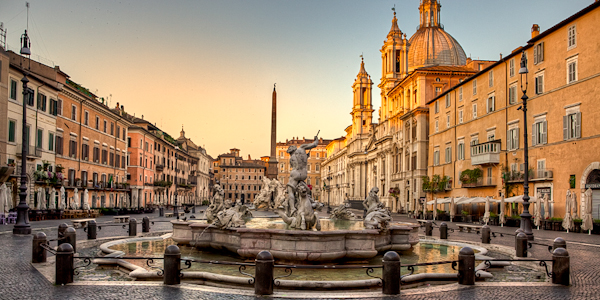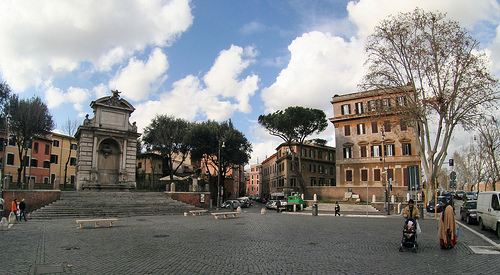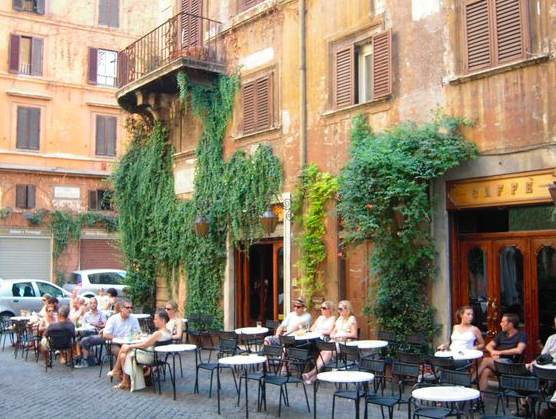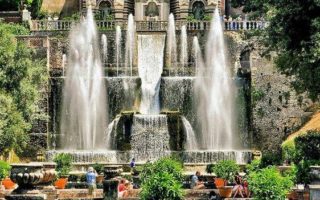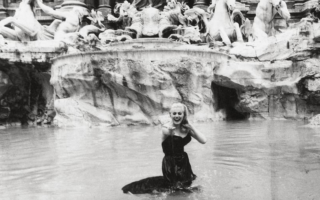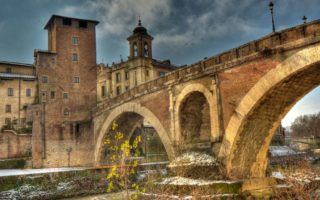PIAZZA HOPPING IN ROME
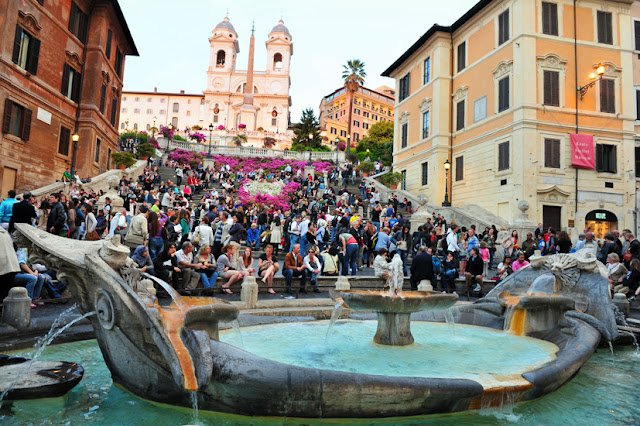
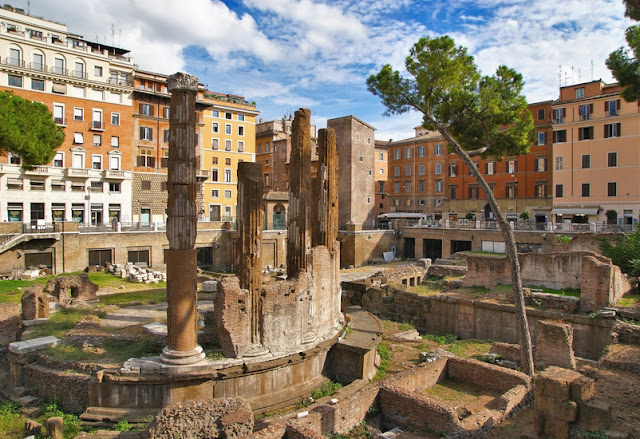
Piazzas (or town squares as we would say in English) have long been the beating hub of Italian towns – that central space where the community gathers. Technically speaking they are open cobbled or paved spaces (typically a square(ish) shape) where two or more streets convene. Here the locals gather, markets, festivals and events take place, and traditionally you could find the baker, butcher, delicatessen. Nowadays, Italian piazzas are often a jumble of market stalls and tables and chairs stretching from bars or restaurants. Local oldies sipping their morning coffee or grappa as they watch the world go by, tourists soaking up the atmosphere and children playing in the open space. A fountain or statue often dominates the centre of a piazza, and this is no exception with our Roman examples.
Let me take you on a hop-through-Rome via five of its piazzas – I’ve chosen a tiny sample of the hundreds that the whole city boasts and I’ll give you a little history, what happens there, and where to eat/drink.
Piazza Navona
The lowdown? Undoubtedly Rome’s proud prince of the piazzas, Navona stands in the center of Centro Storico, nestled between the river, the Pantheon and infinitely winding cobbled streets. One of the largest of the piazzas, Navona is a long rectangle shape, bursting with monuments and encased within Baroque buildings. Since the 15th century it has been THE public space; previously for the local Romans, and now for the hoards of tourists who mix and mill there both day and night.
Check out? The largest building in the piazza is Palazzo Pamphilj which was originally built in the 17th century for Pope Innocent X, but is now the Brazilian Embassy. At the south end is an enticing archway which leads to the museum of Palazzo Braschi. Let’s take a moment for the monuments – the ‘piece de resistance’ is Bernini’s glorious Fontana dei Quattro Fiumi – an impressive fountain which personifies the four rivers of Danube, Ganges, Nile and Plate encompassing the huge Obelisk of Domitian. Bernini clearly wanted to leave his mark on Navona as he adjusted Giacomo della Poreta’s Fontana del Moro a century later by adding a Moor wrestling a dolphin in the center. And finally, Fontana del Nettuno in which we see the dramatic sculptural struggle between Neptune, flanked by sea nymphs, and a sea monster.
Back in the day? Piazza Navona stands on the site of the 1st century Stadium of Domitian and we can see how its form replicates the original arena shape. It was there that the original Romans gathered to cheer, shout and partake in ancient games. Today, the buzz of visitors’ voices is but an echo of the roar that would have emanated from the heart of this square. Across the centuries Navona has been the site of theatrical events, in fact during the time of the Pamphilj family residence, the square was flooded every Saturday and Sunday in August as part of the celebrations and recreations.
And now? Piazza Navona can often feel like a circus; an architecturally stunning one at that. Expect street artists, balloons, stalls of shiny, colorful and loud trinkets, the calls of local vendors and waiters cooing passersby to dine. You’ll spot the locals as those with their noses down and their march on. Its a buzzing, vibrant piazza that rewards the eye at all times of day or night.
Where to head? A word of warning – Navona is notoriously designed for the unknowing tourist who can be woo-ed by the charming waiter into a restaurant that serves food which, to be brutally honest, Italians wouldn’t touch with a bargepole. I’ve been there, I’ve made the mistake. However, I have discovered the answer – Vivi Bistrot! Hidden under the arch to Palazzo Braschi is this organic food serving bistrot with genuinely tasty and quality food, and the most unassuming yet stunning view of the piazza. Go. For a traditional dinner, turn right when facing Vivi Bistrot and straight ahead to Cul de Sac – an enoteca which has admirably managed to retain its Roman character. Walls lined with wine bottles, a traditional menu and the atmosphere of a local’s haunt.
Piazza del Popolo
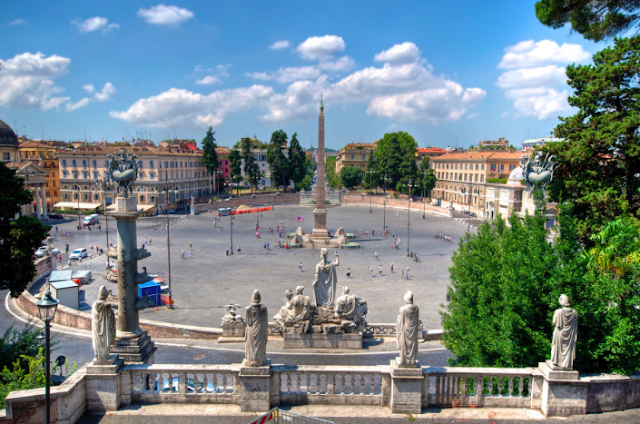
The lowdown? Named the piazza of the people, Popolo certainly is that. A large oval piazza sat between the river Tiber, the northern Porta of Rome’s original walls, the gardens of Villa Borghese and the main shopping streets, it’s easy to understand why people can’t get enough of it. Its round form almost draws its visitors into a rhythmic flow as they circle the centre.
Check out? So much to mention! The unmissable central obelisk – the Egyptian obelisk of Sety I from Heliopolis that started its life in Circo Massimo when it first arrived, before later being moved to its current position. Four elephant fountains flank the central monument and the steps provide an ideal seating area for visitors. The ‘twin’ churches Santa Maria dei Miracoli and Santa Maria in Montesanto herald the start of via di Ripetta (if you’re feeling designer and high end shopping) and via del Corso (if you’re after high street brands).
Back in the day? Piazza del Popolo has a cool history. Being by one of the original ‘doors’ to Rome and that which connects via Flamino, THE road to the north, Popolo was the first glimpse of Rome that travellers back in the day had. The piazza was also the place in which public executions were performed – lovely. At the beginning of the 19th century Piazza del Popolo in its current state was born thanks to Giuseppe Valadier under the commands of Pope Sixtus V whose civil engineering plans transformed medieval Rome into a renaissance/baroque masterpiece.
And now? A sun trap that entices visitors and local workers on their lunch breaks alike to convene, eat and chat. Typically there will be a token few trinket vendors, but the size and shape of the piazza really encourages a movement and feeling of space and energy.
Where to head? The beauty of this piazza is that eating locations are limited but none have been too “touristified”. And so Canova by via Ripetta is the perfect spot to sit outside and enjoy a drink or food. Equally Dal Bolognese is recommended for a meal.
Piazza Repubblica

The lowdown? A 19th century piazza a stones throw from the central station of Termini, at the head of one of Rome’s main central streets – via Nazionale. Easily overlooked as a busy junction – this piazza truly deserves some attention and time.
Check out? The scandalous fountain in the centre of the roundabout – Fontana delle Naiad was designed in 1888 by Alessandro Guerrieri but brought into being by the architect Mario Rutelli in 1901. The fountain boasts the figure of Glaucous wrestling a fish in the centre plus four nude nymphs reclining on different animals representing water; a water snake for rivers, a sea-horse for oceans, a lizard for streams and a swan for lakes.
Back in the day? The piazza was born with a different name ‘piazza dell’esedra’ which was inspired by the ‘exedra’ in the Terme di Diocleziano and its form mirrors the shape. The porticos encompassing the piazza were constructed in the late 19th century.
And now? Very much a working piazza, expect streams of traffic, weaving taxis, horns blaring and smart cars bouncing over the cobbles around the central fountain. Escape to the porticoed colonnades to watch from a safe distance.
Where to head? Head to Eataly for all your food, drink and shopping needs. The younger sister of Ostiense’s mega Eataly, Repubblica hosts the smaller version of this true Italian store. Stock up on legitimate and quality Italian produce and sit down under the colonnade to eat overlooking the piazza. I’m also a fan of the Exedra hotel for its rooftop and bar selection. Avoid everything on the opposite side of the piazza.
Piazza Trilussa
The lowdown? THE stepping stone from Ponte Sisto into the ever popular and characteristic zone of Trastevere. Trilussa is an arms-open-wide welcome to the other side of the Tiber river; a piazza whose energy can be felt radiating throughout the cobbled streets surrounding.
Check out? The simple piazza is dominated by the elegant flight of steps leading up to the 17th century Travertine Fountain whose arch, columns, dragons, lions and cascading water are a feast for the eyes and ears. Interestingly, note the Borghese coat of arms which decorates much of the structure. And of course, take time to appreciate, arguably, one of the Rome’s most beautiful and well-loved bridges.
Back in the day? One wonders how impressive Trilussa was without its fountain, and although the structure is 17th century it was only moved to its current position in the piazza in the late 19th century. After its commission from Paolo V Borghese, the fountain sat for two centuries at the end of via Giulia before its relocation and the addiction of steps to make it visible from Ponte Sisto.
And now? By day a thriving walkway and spot to stop with a sandwich or slice of pizza, and by night a hub of activity. As the sun sets, young (and older) people gather on the cobbles, on the steps, and the atmosphere becomes vibrant, buzzing and full of life and passion. It is the place to meet friends over a beer or wine.
Where to head? The great thing about this piazza is that it is quite simply surrounded by tasty and traditional bars and restaurants. You can’t go too far wrong (as long as you avoid the garishly bright photo emblazoned signs) so here are a few places just off Trilussa – Meccanismo is on the piazza and as well as evening food and drinks, has an excellent tea and sweets selection for the afternoon. Freni e Frizioni is a well-loved gathering hub for those wanting a drink in a cool atmosphere just above Trilussa. For dinner, Osteria da Zi Umberto is tucked around the corner and serves fairly priced and reliable Roman food.
Piazza Sant’Eustachio
The lowdown? There’s something intriguing and beguiling about this piazza, which despite being slap-bang in the centro storico area and a stone’s throw from many of Rome’s top sites, namely the Pantheon and Navona, remains understated.
Check out? Sant’Eustachio boasts the heart of the Italian government Republic – the Senate which is based in the impressive Palazzo Madama. Take a moment to look up at the fresco adorned building beside the church of Sant’Eustachio. Dating from the 16th century, the chief chamberlain of the Cardinal at the time had the façade decorated with scenes of Sant’Eustachio’s life, as well as the Medici coat of arms. On via Sant’Eustachio are the two remaining columns of the Baths of Nero – dating back to AD 62, and outside Palazzo Madama is a fountain basin also of the same origin.
And now? The piazza tends to be a blend of suited locals and camera-clutching tourists milling through; some soaking up every corner and façade, some waking through unawares.
Where to head? No-one should leave this piazza without trying what is claimed to be the best coffee in Rome at Sant’Eustachio Il Café – do note the price increase to be seated before you get carried away ordering. Ginger Sapore e Saluti is a more affordable, healthy and elegant alternative for a fresh snack. Another unusual niche option is La Salmoneria in which you can find all the salmon, fish and salads you could imagine.
Written by: Holly Streader
If you liked this article, read also “HIDDEN GEMS OF ROME“
